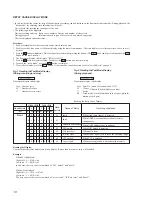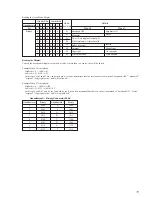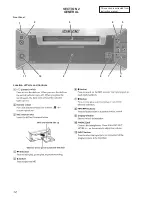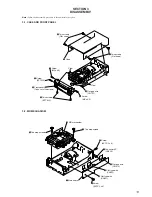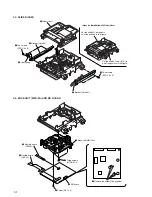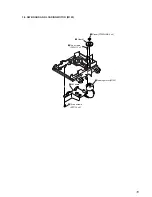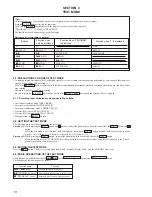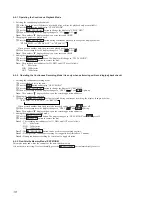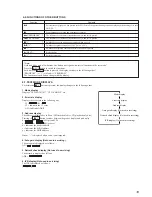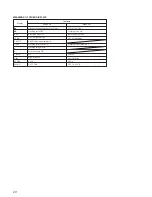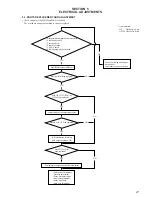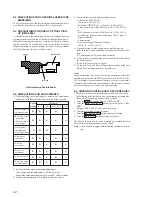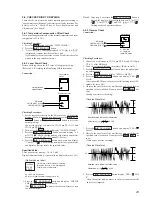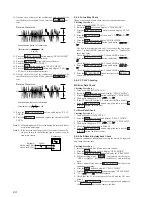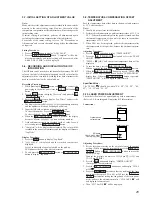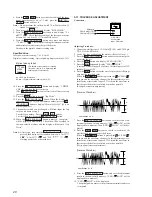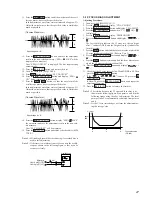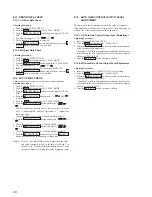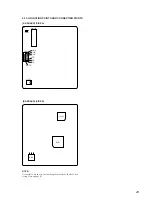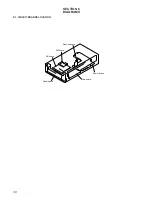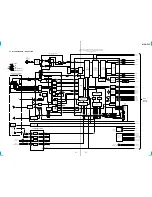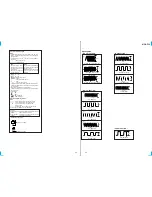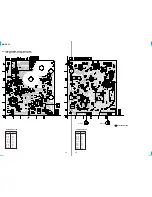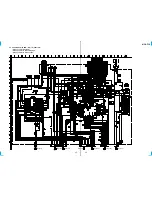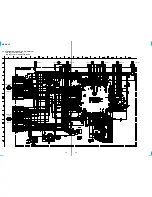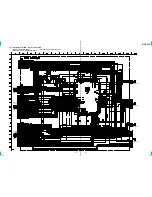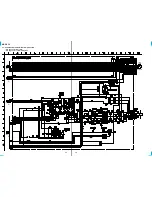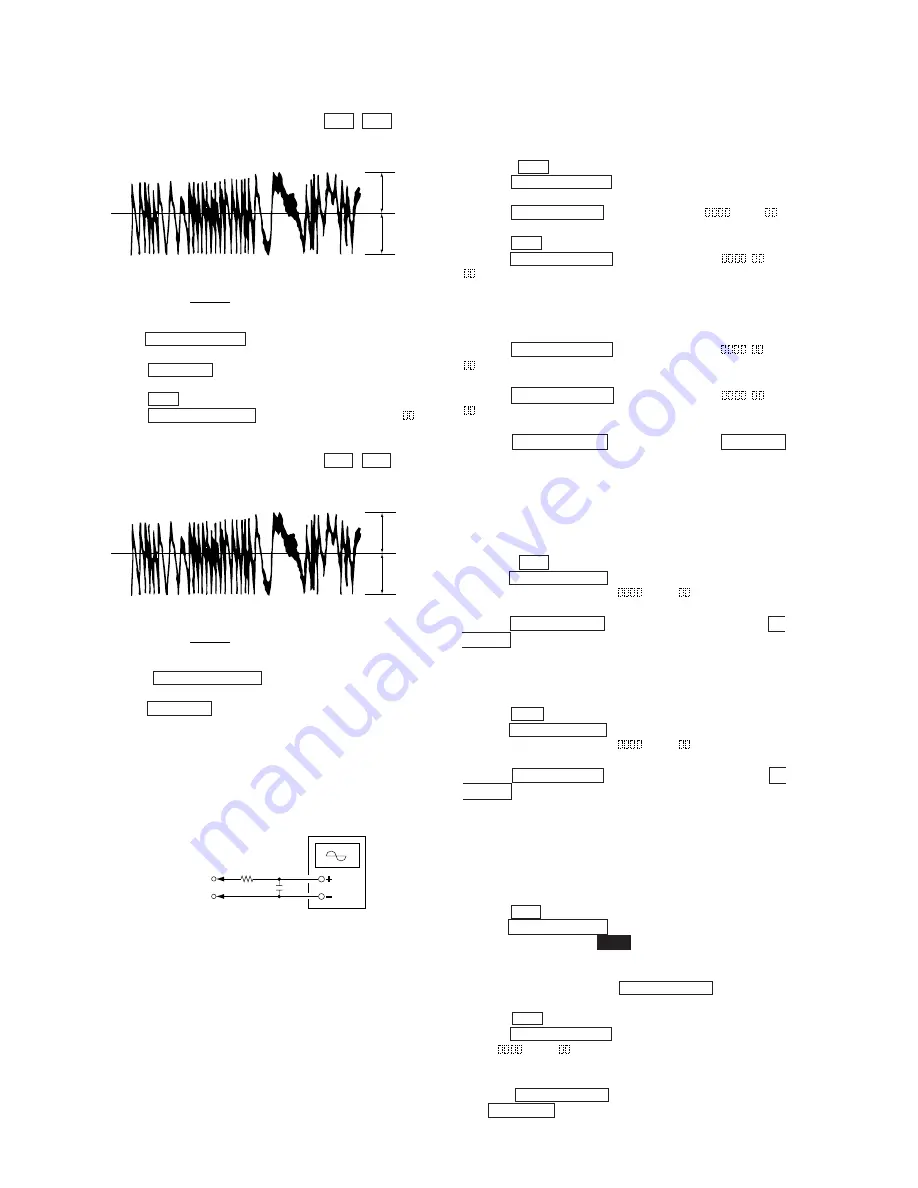
24
5-6-4. Focus Bias Check
Change the focus bias and check the focus tolerance amount.
Checking Procedure :
1. Load a test disk (MDW-74/AU-1).
2. Rotate the
+
button and display “CPLAY MODE”.
3. Press the
^
“PROGRAM” button twice and display “CPLAY
MID”.
4. Press the
p
“PROGRAM” button when “C1 =
AD =
”
is displayed.
5. Press the
+
button and display “FBIAS CHECK”.
6. Press the
^
“PROGRAM” button and display “
/
c =
”.
The first four digits indicate the C1 error rate, the two digits
after “/” indicate ADER, and the 2 digits after “c =” indicate the
focus bias value.
Check that the C1 error is below 220 and ADER is below 2.
7. Press the
^
“PROGRAM” button and display “
/
b =
”.
Check that the C1 error is below 220 and ADER is below 2.
8. Press the
^
“PROGRAM” button and display “
/
a =
”.
Check that the C1 error is below 220 and ADER is below 2.
9. Press the
p
“PROGRAM” button, next press the
6
(EJECT)
button, and remove the test disc.
5-6-5. C PLAY Checking
MO Error Rate Check
Checking Procedure :
1. Press a test disk (MDW-74/AU-1).
2. Rotate the
+
button knob and display “CPLAY MODE” .
3. Press the
^
“PROGRAM” button and display “CPLAY MID”.
4. The display changes to “C1 =
AD =
”.
5. If the C1 error rate is below 80, check that ADER is below 2.
6. Press the
p
“PROGRAM” button, stop playback, press the
6
(EJECT) button, and test disc.
CD Error Rate Check
Checking Procedure :
1. Load a check disc (MD) TDYS-1.
2. Press the
+
button knob and display “CPLAY MODE”.
3. Press the
^
“PROGRAM” button and display “CPLAY MID”.
4. The display changes to “C1 =
AD =
”.
5. Check that the C1 error rate is below 50.
6. Press the
p
“PROGRAM” button, stop playback, press the
6
(EJECT) button, and the test disc.
5-6-6. Self-Recording/playback Check
Prepare a continuous recording disc using the unit to be repaired
and check the error rate.
Checking Procedure :
1. Insert a recordable disc (blank disc) into the unit.
2. Press the
+
button knob to display “CREC MODE”.
3. Press the
^
“PROGRAM” button to display the “CREC MID”.
4. When recording starts, “
REC
” is displayed, this becomes
“CREC (@@@@)" (@@@@ is the address), and recording
starts.
5. About 1 minute later, press the
p
“PROGRAM” button to stop
continuous recording.
6. Press the
=
button to display “C PLAY MODE”.
7. Press the
^
“PROGRAM” button to display “C PLAY MID”.
8. “C1 =
AD =
” will be displayed.
9. Check that the C1 error becomes below 80 and the AD error
below 2.
10. Press the
p
“PROGRAM” button to stop playback, and press
the
6
(EJECT) button and remove the disc.
10. Observe the waveform of the oscilloscope, and check that the
specified value is satisfied. Do not press the
=
,
+
but-
tons.
(Traverse Waveform)
11. Press the
^
“PROGRAM” button display “EF MO CHECK”
The disc stops rotating automatically.
12. Press the
6
(EJECT) button and remove the disc.
13. Load the check disc (MD) TDYS-1.
14. Press the
+
button and display “EF CD CHECK”.
15. Press the
^
“PROGRAM” button and display “EFB =
CD”. Servo is imposed automatically.
16. Observe the waveform of the oscilloscope, and check that the
specified value is satisfied. Do not press the
=
,
+
but-
tons.
(Traverse Waveform)
17. Press the
^
“PROGRAM” button and display “EF CD
CHECK”.
18. Press the
6
(EJECT) button and remove the check disc (MD)
TDYS-1.
Note 1 : MO reading data will be erased during if a recorded disc is
used in this adjustment.
Note 2 : If the traverse waveform is not clear, connect the oscillo-
scope as shown in the following figure so that it can be
seen more clearly.
VC
A
B
Specified value : Below 10% offset value
Offset value (%) = X 100
I
A – B
I
2 (A + B)
VC
A
B
Specified value : Below 10% offset value
Offset value (%) = X 100
I
A – B
I
2 (A + B)
330 k
Ω
Oscilloscope
10pF
BD board
CN110 pin
3
(TE)
CN110 pin
1
(VC)

